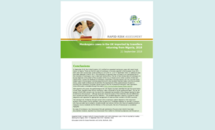Rapid risk assessment: Monkeypox cases in the UK imported by travellers returning from Nigeria, 2018
The risks assessed in this document are of the introduction and further spread of monkeypox in the EU/EEA, infection with regards to different settings (e.g. healthcare, community, etc.) and transmission through SoHO.
Executive Summary
In September 2018, the United Kingdom (UK) notified two separated monkeypox cases with recent travel history to Nigeria. These are the first cases of monkeypox in humans reported in the European Union (EU). Both cases were symptomatic while travelling by air to the UK. As of 17 September 2018, no additional cases have been detected in the EU (EU). The notification of imported cases in Europe is not unexpected due to the circulation of monkeypox virus in West and Central Africa. The risk of new introductions of monkeypox to Europe depends on the extent of the circulation of the virus in Nigeria and in other countries of West and Central Africa. Overall, the likelihood of monkeypox importation in Europe remains very low, but new travelrelated cases in the European Union/European Economic Area (EU/EEA) Member States cannot be excluded. Hence, public health professionals should follow the development of the epidemiological situation in countries with monkeypox circulation and be aware of the risk of potential monkeypox case importation (more information is available through the weekly ECDC Communicable disease threats reports).
With regards to this event, the epidemiological link with Nigeria has been identified through the travel history in both cases, therefore West African monkeypox clade is expected to be the aetiological agent. The risk for spread in the EU/EEA remains very low due to the moderate transmissibility of the disease reported to date, its distinctive clinical picture − although physicians should be aware of the similarities with and differences from varicella and other human poxvirus infections − the available laboratory capacity in Europe for rapid diagnostics and capacities for appropriate management of cases and their contacts in EU/EEA countries.
The individual risk of infection through contact with a monkeypox patient depends on the nature and duration of the contact. Family members, close contacts (e.g. immediate neighbour on aircraft), or persons who have provided care to patients, including health care workers (HCWs) who have not applied preventive measures, have a moderate risk for infection. In the community, the risk of transmission is considered negligible.
No cases of monkeypox virus transmission through substances of human origin (SoHO) have been documented. However, reported virus transmission from mother to child during pregnancy and through an invasive bite or scratch from an ill animal suggest that transmission via SoHO is theoretically possible. There are no data on the beginning of viraemia during the incubation period or in possible asymptomatic cases. No chronic carriage of the virus has been reported. Thus, the risk of monkeypox virus transmission through SoHO is difficult to assess.
Download





